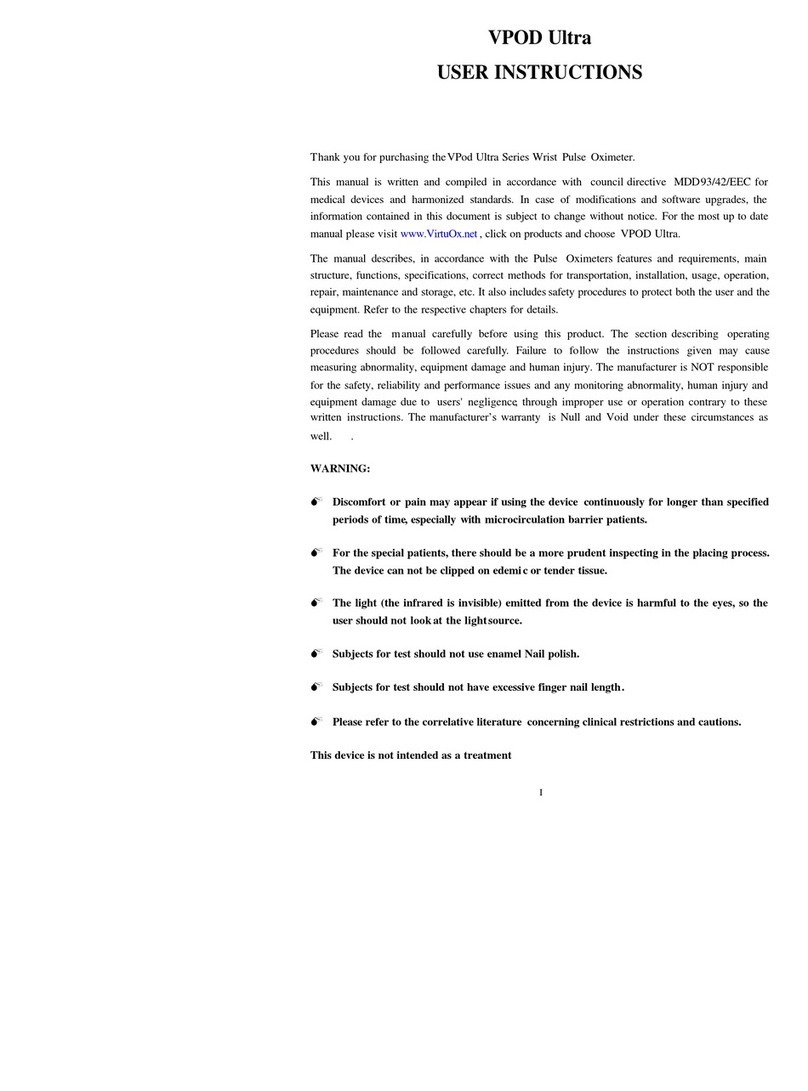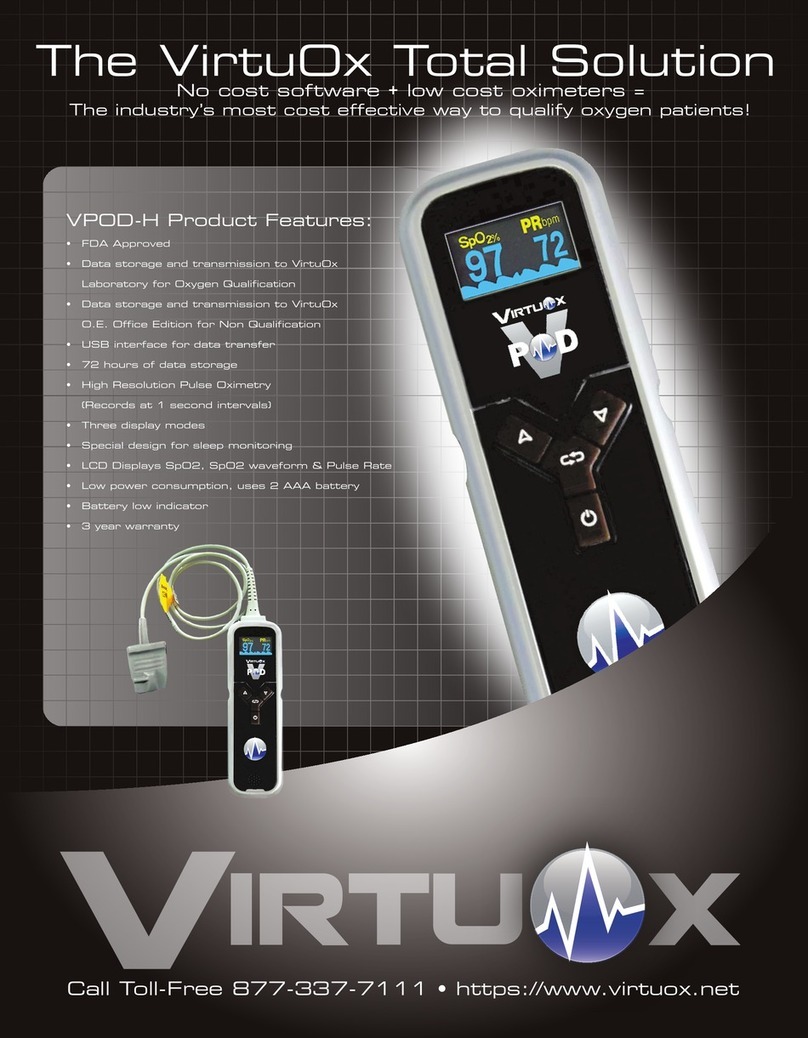
Ver1.2
VPOD OPERATOR'S MANUAL
4
2.5.3 Extremely high illumination could affect the SpO
2
measurement. Use a semi-translucent or opaque cover to shield the sensor.
2.5.4 Other factors
a) High-frequency electrosurgical interference from external devices, including defibrillators.
b) Placement of a sensor on an extremity that currently has installed a blood pressure cuff, arterial catheter, or intravascular line;
c) The patient has hypotension, severe vasoconstriction, severe anemia, or hypothermia;
d) An arterial occlusion proximal to the sensor.
Warning
Use only SpO
2
sensors provided by manufacturer. Other SpO
2
sensors may cause improper performance.
Do not use an SpO
2
sensor with exposed optical components.
Excessive patient movement may cause inaccurate measurements.
Tissue damage can be caused by incorrect operation or misusing sensor; for example, by wrapping the sensor too tight. Inspect the sensor site to ensure the skin’s integrity and the adhesion
position of the sensor is correct. More frequent inspection should be taken if necessary.
Loss of pulse signal can occur in any of the following situations:
a) The sensor is too tight;
b) There is excessive illumination from light sources such as a surgical lamp, a bilirubin lamp, or sunlight;
c) A blood pressure cuff is inflated on the same extremity as the one to which an SpO
2
sensor is attached.
CHAPTER 3 DETAILED OPERATION
3.1 Display
The handheld pulse oximeter uses an LCD display for readout. It can display the SpO
2
and pulse rate (PR) value, as well as a pulse column and SpO
2
waveform.
There are three display modes shown in Fig 3.1. The first figure is pulse column display mode. The second figure is filled waveform mode. The third figure is line waveform mode indicating SpO
2
%
trend.
(1) (2) (3)
Fig 3.1 Three display modes
SpO2: Percent oxygen saturation value displayed above is 98%
PR: Pulse rate value displayed is 72 bpm
Pulse column: This is used for signal identification and quality indication during motion and low signal to noise situations. The bar rises and falls with the pulse, its height indicating signal
quality. When the bar is very low, the SpO2 and pulse rate values may be suspect.
Signal strength: Indicates arterial pulse signal strength and may be used as a diagnostic tool during low perfusion for the accurate prediction of illness severity. The bar is highest when the
quality of the perfusion state is best and low when the perfusion is poor.
PR tone modulation: Beeps in sync with the patient’s pulse, even under most challenging patient motion conditions.
3.2 Mode Introduction
Power On - Measurement and operation can be done normally. There are three display modes: “Measure mode”, “Information display mode” and “Trouble display mode”.
1) Display modes
“Measure mode”: the sensor is plugged in correctly, and the finger is properly in the sensor, the oximeter is in the measurement mode for both SpO
2
and PR.
“Information display mode”: The sensor is not plugged into the oximeter or the sensor is plugged in the oximeter but the finger is not in the sensor, “Probe off” or “Finger off” will be displayed
respectively, and it will automatically power Off if either information display lasts for more than 8 seconds.
“Trouble display mode”: In the failure state, the oximeter will display error information, and will automatically power Off if the information display lasts for more than 8 seconds. For error information
details and definitions, please refer to chapter 4.2.
2) Definition of key
There are two keys in the oximeter: “Function key (left key)” and “Setting key (right key)”.
“Function Key”: Located at the left of the oximeter, this acts as a Power On switch when the unit is in an Off condition. When the unit is On, it acts as a Function key
“Setting key”: Located at the right of the oximeter, it has no function when the power is off. When the unit is On, it acts as a Setting key.
3) Definition of Key Press
There are three ways to press the key:
Press: press the key quickly, the duration time should no more than 1 second.
Double press: Two-time continuous press, the time between the two press actions should be no more than 0.5 second.
Extended press: Press the key for more than 1.5 seconds.
3.3 Key Functions
1) Power On/Off
Press the Function key (left key) to power on.
The oximeter will power off automatically under the “information display mode” or “trouble mode” for 8 seconds.
2) The Display Mode setting can only be enabled under “Measure mode” and “Information Display mode”. Pressing the Function key (left key) or Setting key (right key), the display mode may be
changed sequentially between “Filled Waveform”, “Line Waveform” and “Pulse Column Waveform”. Once you choose a certain mode, the oximeter will continually display in this mode until changed
by the user.
3) Setting Mode
Entering or exiting the Setting Mode can be done only under the “information display mode”. You can set Brightness, Patient ID, Date and Time under the “Setting Mode”. Current parameters and data
will be displayed at the top right corner which is used to display the “PR”. The various parameters display title is as follows:
Br – Brightness (range:1-10)
ID - Patient ID (range:1-10)
Y – Year (range:0-99)
M - Month (range:1-12)
D – Day (range:1-31)
H – Hour (range:0-23)
M - Minute, (range:0-59)
S – Second (range:0-59)
a) Enter “Setting mode”
































